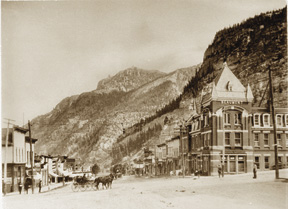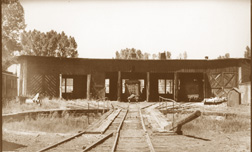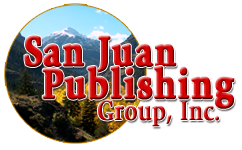February 13, 2015
Ouray County History & Heritage
THREE VERY DIFFERENT ASPECTS of western Colorado history are still alive and well in Ouray County: Colona, a supply point and old stage stop; Ridgway, a railroad town and ranching center; and Ouray, first settled by miners and their families.
Colona’s first settlers came in 1874, bringing their families. They developed ranches and farms in the fertile land on both sides of the Uncompahgre River and found friendly Ute Indians who had lived there for years. The railroad came through Colona in 1887 and stopped twice a day, allowing ranchers to ship their cattle back east and reap a good income.
 Ouray was born in 1875 when silver, gold and other precious ores were discovered in the surrounding mountains. News spread quickly to the east, and soon Ouray became a unique mining town filled with eager men and formidable women seeking a quick fortune. Saloons, gambling halls and houses of prostitution quickly followed. The mining camp grew into a town, becoming more “civilized,” with its own water works, the Ouray Hose Company to put out fires, a community hall, and by 1876, a school district. By 1884 Ouray had three churches and several substantial buildings: a hospital, the County Courthouse, Beaumont Hotel and Wright Opera House were built in 1887 and 1888.
Ouray was born in 1875 when silver, gold and other precious ores were discovered in the surrounding mountains. News spread quickly to the east, and soon Ouray became a unique mining town filled with eager men and formidable women seeking a quick fortune. Saloons, gambling halls and houses of prostitution quickly followed. The mining camp grew into a town, becoming more “civilized,” with its own water works, the Ouray Hose Company to put out fires, a community hall, and by 1876, a school district. By 1884 Ouray had three churches and several substantial buildings: a hospital, the County Courthouse, Beaumont Hotel and Wright Opera House were built in 1887 and 1888.
 Ridgway was officially born in 1890. It was already a railroad town, where the Rio Grande Southern branched off from the Denver and Rio Grande coming up from Montrose to Ouray, then west over the mountains. The town rapidly became a center of building activity beginning with a roundhouse and depot.
Ridgway was officially born in 1890. It was already a railroad town, where the Rio Grande Southern branched off from the Denver and Rio Grande coming up from Montrose to Ouray, then west over the mountains. The town rapidly became a center of building activity beginning with a roundhouse and depot.
Today visitors to these three towns find much to remind them of the past. The valleys on both sides of the Uncompahgre River are filled with beautiful homes located on the original ranches and farms that are often owned by the same families that founded them. The Uncompahgre River still serpentines through the valley with the highway bordering the west side.
In Ouray, visitors view the same breathtaking beauty that greeted the earliest miners. The small town is surrounded by a circle of towering mountains, with the Uncompahgre River rushing through the town. Canyon Creek still races down a valley from the southwest to join the larger river. Just before they meet, it turns into a roaring waterfall dropping eighty feet into a narrow gorge-like cavern at Box Canyon on the south end of town. Across town to the northeast, Cascade Falls descends from the high mountains of the Amphitheater. Downtown, many of the old commercial and residential buildings are still in use today. Ouray’s History Museum, in the old Ouray County Hospital on 6th street, offers outstanding exhibits and displays, one of the best an old “mine” in the basement, complete with assay office, glowing minerals and more.
Hot Springs. The Indians discovered the pleasures of the Ouray’s natural hot springs that are just beneath the surface of much of Ouray County. The springs were later used for medicinal purposes and today provide hot soaks at several hotels, the Ouray Hot Springs Swimming Pool, Ridgway’s Orvis Hot Springs and various “secret spots” throughout the area.
Ridgway has grown and changed, but some of the old buildings are still in use downtown. And, while the days of the railroad are gone, the Ridgway Railroad Museum, at the intersection of Highway 62 and US 550, offers displays and research opportunities. Displayed outside is an exact replica of Motor Number One, the original Galloping Goose of railroading fame, which was built in Ridgway. An annual railroad days every spring celebrates the town’s railroad history. Ridgway was also the commercial center for local ranches, some of which stretched clear into neighboring Utah. The rich ranching history is celebrated every Labor Day weekend, when visitors and locals flock to the fairgrounds for the Ouray County Fair and Rodeo.
Colona. For a year-round look of the county’s ranching history, visit the Ouray County Ranch History Museum in Colona. These three towns, Ouray, Colona and Ridgway, provide fascinating histories set in one of the most beautiful locations in the nation.
Story by Doris H. Gregory, © San Juan Publishing Group, Inc. All rights reserved.
Photos courtesy Ouray County Historical Society. All rights reserved.
